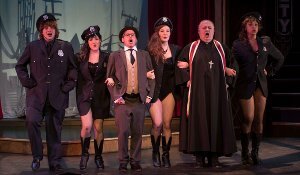What a great gift the Lord has given us in teaching us to forgive and in this way to touch the Father’s mercy!

Book Makes a Great Point
Written by Alan Hustak for VMO
Monday, March 9th,
The publishing industry being what it is these days, you won’t find a copy of Dave Flavell’s oral history of Griffintown, Point St. Charles and Goose Village in any Montreal bookstore. Newspapers in town have taken no notice of it either. But for anyone interested in the social history of Montreal’s storied English-speaking Catholic tenement neighbourhoods, Flavell's book, Community and the Human Spirit is well worth ordering online. Like Patricia Burns’ Shamrock and The Shield, Flavell's book captures a chorus of voices to chronicle a time and place that no longer exists.
He, again like Burns, conducted a slew of interviews with people who grew up in the three tough slum neighbourhoods that used to be in close proximity to each other at the east end of the Lachine Canal. The railway tracks along Mullins separated the French from the Irish and, for the most part the Italians gravitated to Victoriatown, or Goose Village, which was razed in the 1960s.
What they had in common was the church - St. Ann’s in Griffintown, St. Gabriel’s in the Point, and the dedicated clergy who ran the schools. In some instances the priests and nuns appear to be as tough and as resilient as the congregations they served, “never shy to use a strap or other forms of corporal punishment.”
Flavell is a sociologist, not a historian. His book “tells the stories of the importance and the meaning of community as well as the strength of the human spirit.” Among those he interviewed are a colourful lot natural storytellers such as former Montreal Police Chief Bob Cote who grew up in The Point, Joe Berlettano who worked for many years running camps for Catholic Community Services, Margaret Healy, the den mother of the local Irish community, firefighter Joe Timmons and police officer Mike Spears.
Rivalry between the three neighbourhoods was intense and brawls between French and English, Catholic and Protestant are well documented. But as Mike Spears recalls:
“Nothing serious, the odd punch in the head – or run like hell. You won some and lost some, but there was no hatred. Just something to do.” Spears was an altar boy at St. Gabriel’s, and remembers the experience with affection.
“The good thing about being an altar boy was when there was a funeral during the week you could leave school to serve Mass and earn a dime. A lot of times you’d tell the teacher you had a funeral to serve, which was not true, and you got out of school for an hour or two.”
His older brother, Frankie, he tells us, was the black sheep of the family - a pool shark, pickpocket and con artist, ”who could rob your eyes and come back for your eyebrows.” The spirit of the neighbourhoods is evident in Roger Agnessi’s recollections of Nap’s Tavern, a long and narrow watering hole.
“The French guys would sit at one end, the English guys at the other. There was a no man’s land in the middle where people who didn’t know any better about the Point might stumble in.” Police officer Mike Robert Cote, Chief Inspector with the Montreal Police Department grew up in Pointe St. Charles during “the golden years” after the Second World War, when economic conditions began to improve. Cote began his career doing beat patrol at Station 11.
“Back then we didn’t have the drug problems that we have today. Back then it was beer and wine."
The Village was next to a meat processing plant, which Cote says led to some ridiculous situations.
“Sometimes a cow or a bull would escape, that meant we were about to go on what we called an urban safari. All the police in the area would immediately rush in. Of course to us it was always a bull, because a bull is far more impressive than a cow when you are on an urban safari. Fifty years ago we didn’t have the complex police procedures that we have today. I can tell you, whatever the bull weighed when it got out, it weighed considerably more when we returned it to Canada Packers with all the lead we pumped into it.”
Maurice Harkin, who now lives in Ottawa, contributes a vignette about the Corpus Christi processions.
“In preparation for the event, the people of Griffintown washed down the exteriors of their houses and hung flags and religious artifacts from the windows. They lined the streets and looked out all the windows. It was quite an event back in those days.”
The neighbourhoods, of course, are gentrified, and only a few vestiges of what once was remain.The residents who lived there may have been dirt poor, but they were rich in so many other ways. It was a caring place where people looked after each other, and where no one locked their doors.
Gordie McCambridge a school principal for many years, moved out of Griffintown years ago but sometimes returns to the area to look around.
“In some ways I find those walks enjoyable,” he says. “ In other ways I find them sad when I think of what we had at one time down there. The sense of community that we enjoyed in those days won’t ever be replaced. It can’t be.”
Community & The Human Spirit
Oral Histories from Montreal’s Point St. Charles, Griffintown and Goose Village
By Dave Flavell. 357 pp,
Petrabooks.ca $19.00 + shipping
Last Night at the Gayete

|
|
|
|
|
|
The Centaur Theatre's - season is drawing to a close with its final production of Last Night at the Gayety, a musical comedy by Bowser & Blue which runs until May 22nd. |
|
|


